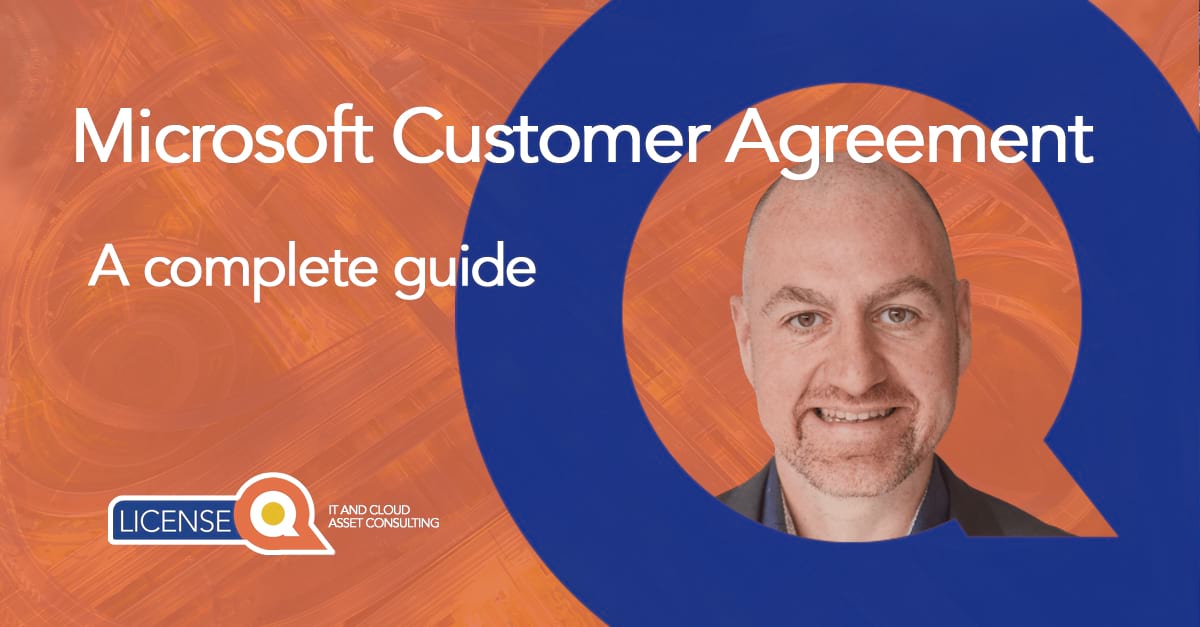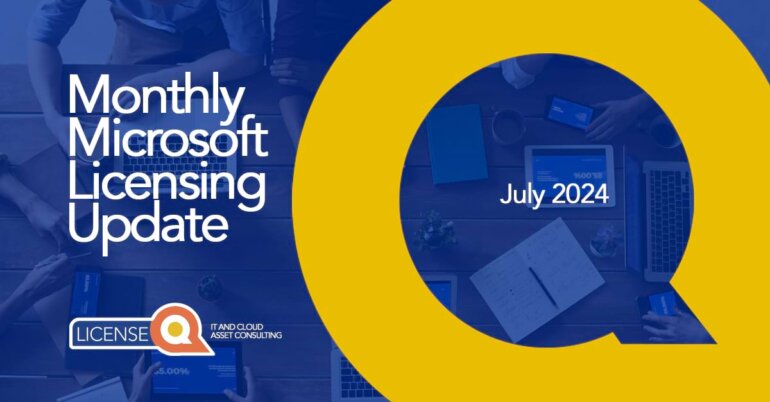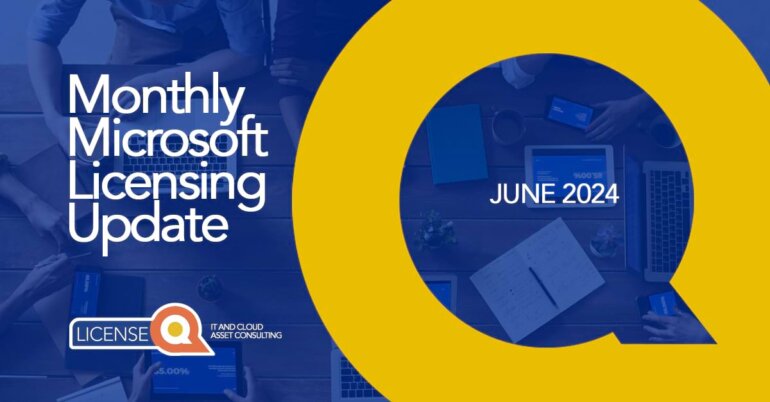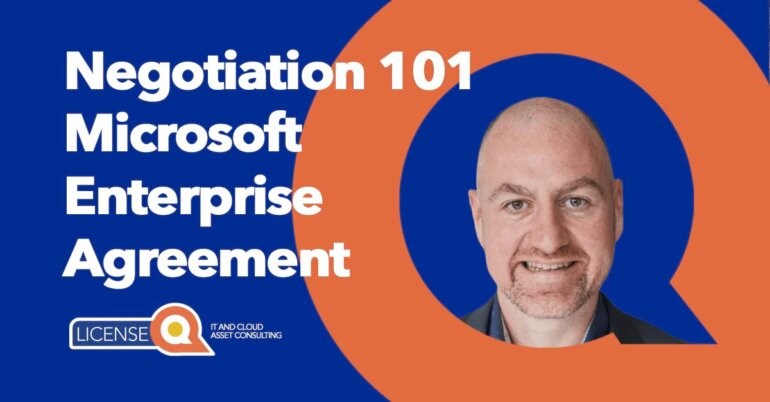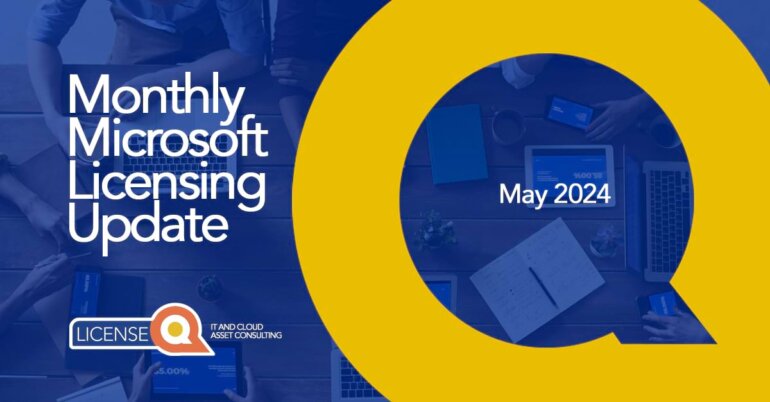How to license the Microsoft Customer Agreement
This article focuses on the Microsoft Customer Agreement as a direct purchasing program offered by Microsoft. We do not focus on the Cloud Solution Provider program, which is also based on the MCA. To learn more about CSP, read our blog Choosing between EA vs CSP.
Topics in this blog
- What is the Microsoft Customer Agreement (MCA)?
- Who should consider the Microsoft Customer Agreement?
- What are the benefits of the MCA according to Microsoft?
- Key takeaways on the MCA
- Visualizing the MCA model
- What is the difference between old vs new licensing models?
- What is the impact of the MCA on Microsoft Partners?
- What to consider when deciding on an MCA?
- Microsoft Customer Agreement & Azure
- Final food for thought
- FAQs
What is the Microsoft Customer Agreement?
The Microsoft Customer Agreement is a simplified, digital, evergreen (non-expiring) contract that allows customers to purchase Microsoft cloud products and services directly from Microsoft. It replaces the older, more cumbersome agreements like the Microsoft Online Subscription Agreement (MOSA) and the Microsoft Products and Services Agreement (MPSA). The MCA is modular, allowing customers to view only the terms relevant to the services they require, making it more user-friendly.
This article focuses on the Microsoft Customer Agreement as a direct purchasing program from Microsoft. We are not describing the Cloud Solution Provider (CSP) program, which is also based on the MCA. We do reference CSP (and web direct) in the text below, but only to show the diversity of options for this contract type.
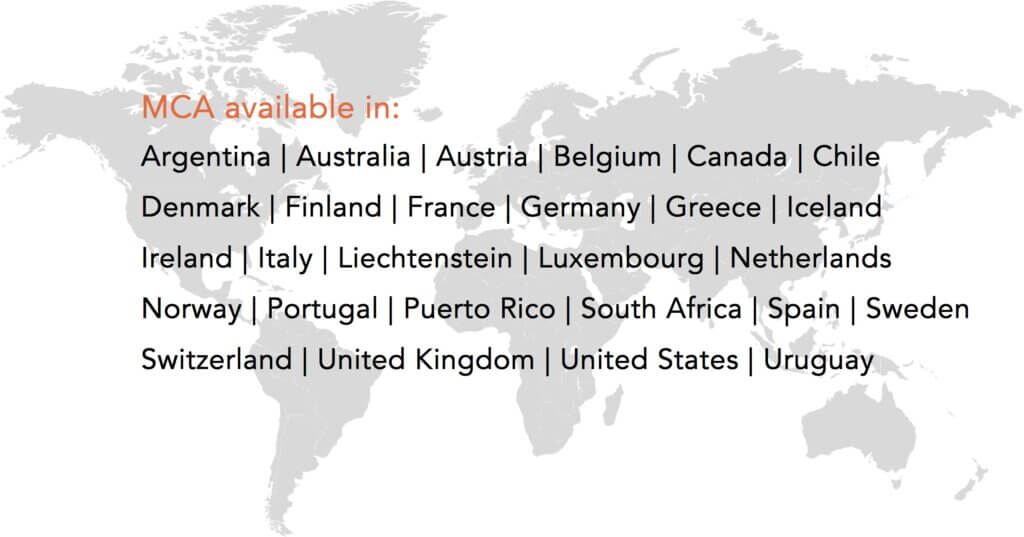
Who should consider the Microsoft Customer Agreement?
If you’re looking for a simpler, more flexible way to purchase Microsoft cloud products and services, the MCA is a great option to consider.
The MCA is available in over 20 countries and currently covers Azure, M365 Copilot, and Windows 365. Right now, this is not an extensive list, but this will change in the very near future. The CSP version of the MCA already offers products and services such as Azure, Dynamics 365, and Microsoft 365.
Procuring cloud services
Rumors of Microsoft’s intention to use MCA-E as a contract vehicle for purchasing seat-based services under M365, D365, W365, and other suites have been circulating since 2020. As of September 2023, this has become a reality. This is a big step for Microsoft as it means it can contract with customers without the use of an LSP. Additionally, it gives the Microsoft customer a new way to procure cloud services.The platform offers you, the end customer, the flexibility to choose how you want to procure Microsoft Cloud solutions: through the website, with Microsoft support, or through a partner. While partner-led procurement has always been an option (CSP NCE), this direct procurement option is new.
Examples of how businesses are using the MCA:
- A small business is using the MCA to purchase Microsoft 365 for its employees. The MCA allows the business to purchase Microsoft 365 on a monthly basis, which is more affordable for the business than purchasing annual subscriptions.
- A mid-sized business is using the MCA to purchase Microsoft Azure for its cloud computing needs. The MCA gives the business the flexibility to scale its Azure usage up or down as needed.
- A large enterprise is using the MCA to purchase a variety of Microsoft cloud products and services, including Azure, Dynamics 365, and Microsoft 365. The MCA allows the enterprise to consolidate all of its Microsoft cloud purchases under a single agreement.
What are the benefits of the MCA according to Microsoft?
- Streamlined purchasing: The MCA is a fully digital agreement that can be accepted and signed in minutes. As you purchase additional products and services, your agreement will incorporate the Terms and Conditions for these products, making you sign for only the Ts&Cs that you require.
- Flexibility: The MCA gives you the flexibility to purchase Microsoft products and services from a variety of partners, including Microsoft directly, cloud solution providers, and system integrators.
- Simplified billing: The MCA provides a single, consolidated bill for all of your Microsoft cloud purchases, making it easier to track and manage your costs.
- Automatic updates: As you add or remove Microsoft products and services, your MCA will be automatically updated to reflect your changes.
Quote
Microsoft Marketing Machine
“The goal of the MCA is to provide a consistent and simplified purchase experience with greater flexibility in how and where you buy.
With the Microsoft Customer Agreement, we’ve introduced a streamlined way to buy. You accept one straightforward purchasing agreement that’s always up to date and doesn’t expire whether you buy directly from Microsoft or a Microsoft partner.
This helps shorten the buying process by getting proposals from your Microsoft sales representative or your partner. There’s less administrative overhead with no lengthy paperwork required. Simply accept the customer agreement and you’re ready to go.”
Key takeaways on the MCA
The quote above is clearly a lot of marketing talk, but there are several key takeaways that jump out for us:- It is a fully digital agreement– What Microsoft means is that you sign the agreement digitally. They might make some exceptions to this, but generally speaking, if you prefer to put ink on paper, this might be a dealbreaker for you.
- Purchasing agreements – Do you remember the MPSA? This contract model is based on purchasing agreements. Customers can sign a single top-level agreement and then create as many purchasing agreements as they need, even for individual departments, affiliates, or even employees. This flexibility is great, but it remains to be seen how it will work in practice with the wide range of Microsoft services available.
- Simplified purchasing experience – Microsoft has been talking about Next Generation Volume Licensing for over 10 years. Yet, innovation on these contract vehicles has been slow. We are only now seeing the first new contract types coming out, and Microsoft has already pulled the plug on the MPSA to work on something else, the MCA. This raises concerns about the future of the MCA.
- No expiration date – Microsoft Customer Agreements (MCAs) do not expire, so they are essentially permanent. This raises a number of questions, such as how committed offers will be introduced, whether beneficial pricing is possible, and whether there will still be any kind of renewal cycle (e.g., one year, three years).
For Azure, customers can add a Microsoft Azure Consumption Commitment (MACC), which allows you to procure Azure services for a specific term. However, it is unclear how this will work for M365 and D365 products.
- Less administrative overhead – It will be interesting to see how this works in practice, as the MCA actually offers custom-made agreements that run for a long time. This requires a whole new approach on both sides

Visualizing the MCA model
Microsoft basically sees the Microsoft Customer Agreement as a large bucket that you can fill with any and all Microsoft product and services offerings. Software, cloud services, subscriptions, Azure, etc.
You can buy products in the MCA through Microsoft, which they call Microsoft-led, through partners or self-service on the website. You can buy these at different times and it means you don’t have to switch between contracts or partners. The MCA replaces the CSP as the Microsoft model working with partner organizations.
What are the differences between old vs new licensing models?
The table below shows the differences between older licensing models and the new MCA:
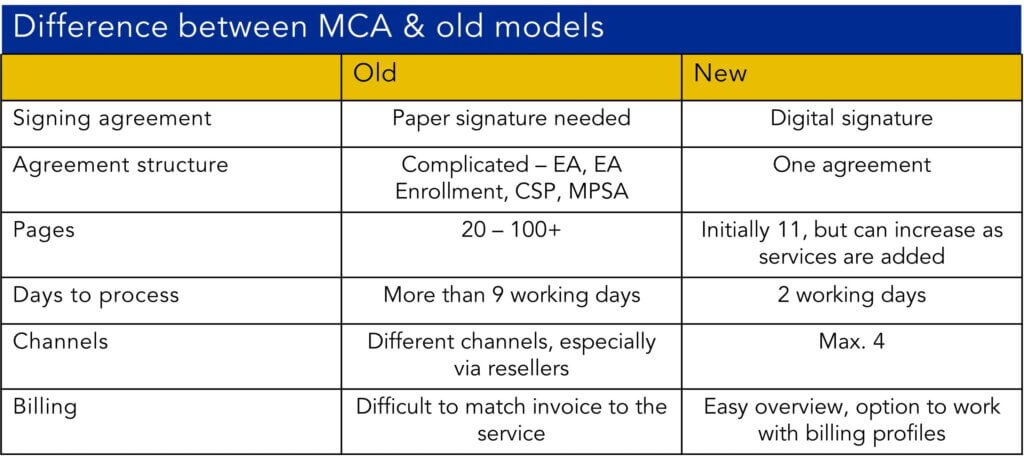
A big difference with old contract models is how you sign the MCA. For example, with the Enterprise Agreement, a customer signs:
- Master agreement
- Enterprise Agreement
- Various Enrollments
- CPS
- Previous contact information form
- Product Selection Form
- Amendments
- Etc.
Signing the MCA
With the MCA, a customer only signs the MCA contract. If you add on a certain product or cloud service, Microsoft will add the specific Terms & Conditions of that service to the MCA. The initial Microsoft Customer Agreement might only be 11 pages (as opposed to 20 to 100+ pages for an EA), but this can expand rapidly as you procure additional products and services.
The processing time of the agreement dropped drastically, to only two days. This is mostly due to a simplification in the number of portals needed to process the MCA. For the EA different portals and systems were needed, especially for larger resellers or LSPs, but for the MCA this should be a maximum of four. Probably the contract portal, the M365 admin portal, the Azure portal and that’s it.
Billing in the MCA
Microsoft documentation indicates that committed offers are also available, with monthly, 12-month, or 36-month terms. Similar to their CSP model, Microsoft offers flexible payment plans, including monthly billing for select subscriptions. A comprehensive list of eligible subscriptions is forthcoming. Additionally, the pricing model remains somewhat unclear, and we will update this section as more information becomes available.
Invoicing is also made easier in the MCA. Before invoicing would have finance departments with their hands in their hair, but in the MCA, this has been made easier and you can even create a billing profile.
Comparing EA vs MCA
Below is a detailed comparison between the Enterprise Agreement (still Microsoft’s main contract type) versus the Microsoft Customer Agreement.
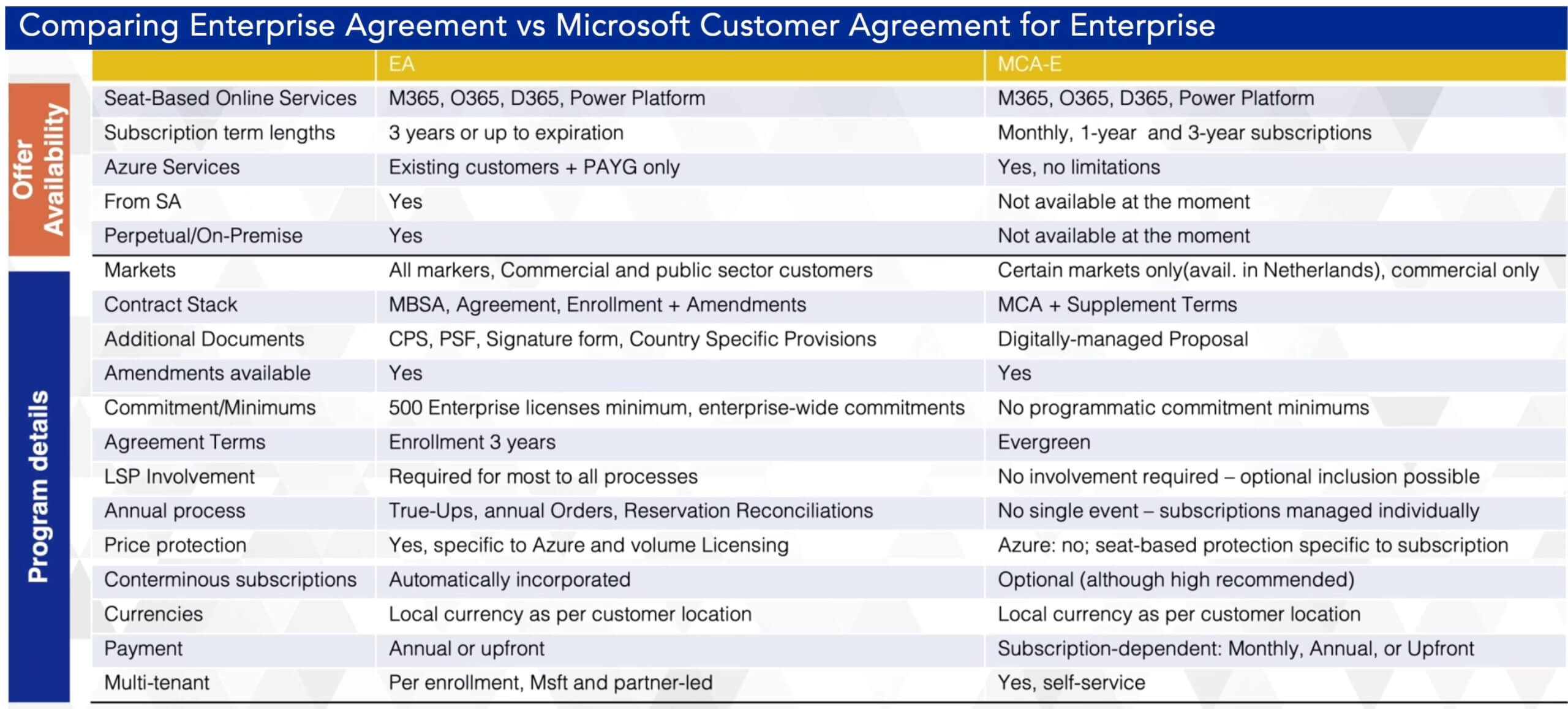
What is the impact of the MCA on Microsoft partners?
Microsoft partners who contract through CSP already use the Microsoft Customer Agreement, as CSP has already migrated to the MCA platform in the form of the New Commerce Experience.
The MCA as such is similar to the current experience with the NCE/CSP program. However, the way it is built up and its intention should lead to more innovation in the future, as it promises to be highly customizable.
Value-added services in MCA
Microsoft’s ‘value-added’ services have a more prominent focus in the MCA, by asking partners to think about if and how they will offer additional services on top of the MCA to help add value to the entire contract stack and portfolio of Microsoft.How is the partner going to make a difference for customers with the MCA platform? And will Microsoft start competing with Microsoft Partners more actively, as they might not require the use of the partners anymore to resell their licenses, if their direct approach works as streamlined as their promise is.
With the change to the contractual model also comes a change in the incentive models for partners. We won’t go into this here, but if you are interested in this, but if you are interested in this, we suggest you to reach out to us to learn more.
What to consider when deciding on the MCA?
1. MCA yet another contract
MCA is yet another contract added to Microsoft’s already vast and complex offer.
2. CSP partners already on MCA
CSP partners have already switched to MCA. Microsoft has kept this promise.
3. Not ready for all cloud services
Not up & running for all cloud services yet in a direct model. We would like to see this as we want to see what committed offers (like you have in the EA) will look in MCA.
4. Impact ITAM
The new MCA structure and portal will impact your ITAM. The MCA does not allow customization or standardization, which may not be for larger enterprise organizations. If you are currently in a heavily customized EA (custom term, special amendments, framework agreements, etc), this same customization might not be possible in the MCA, at least not yet. If Microsoft is to move larger customers with customized contracts to MCA, they need a solution for this.
5. Licensing overviews in MCA
How will Microsoft handle licensing overviews under the MCA? Currently, customers can request a Microsoft License Statement (MLS), but there were problems integrating the MLS into MPSA purchases. This has been a very manual process, but will the MCA be any different?
We heard that Microsoft has released a new internal tool that aggregates all the different licensing programs that a customer might procure under. If this tool works as advertised, Microsoft should release it to its customers to allow them to have the same insights. Additionally, if everything moves to the MCA, how will Microsoft handle licenses that customers have procured in the past? How will Microsoft keep track of these migrations, or is it up to the customer to maintain this information?
6. Price Protection in MCA
Right now, price protection doesn’t exist in Azure through MCA. Enterprise Agreements (EAs) do offer customers three-year price protection, meaning that the price you have at the start of your contract is the maximum you will pay throughout that term. If you move to a Microsoft Customer Agreement (MCA), will this price protection still apply, or will you move to a model where any price increase will immediately affect your consumption month over month.
7. Legal Aspects in MCA
As stated before, custom terms are not included. Microsoft only adds specific standardized amendments already present in the Enterprise Agreement. What will they do in this regard to enable large enterprise to adopt the MCA too?
8. Product & Cloud Service specific language
The MCA only contains the basic terms when you first sign them. If you add services, products, or software to the agreement later, the specific terms and conditions of those add-ons will be written into the MCA. It is not yet clear how this will work in practice.
How will adding these terms work? If you have objections to any of the terms, can you discuss them with Microsoft before signing the agreement? If not, will this delay procurement?
Microsoft Customer Agreement & Azure
At the time of writing, the MCA is only available for Azure. The Microsoft Customer Agreement (MCA) provides a flexible way to purchase Azure, with support for existing capabilities.
- As of November 1st, 2020, you can no longer renew Azure-only Server & Cloud Enrollments or sign new Azure-only SC The only option is to move to MCA.
- If you do not already have Azure in your Desktop EA, you cannot add it anymore, and MCA is your only option. You cannot add Azure to any new Desktop EAs.
- If you do not already have Azure in your SCE, where you also procure SQL and Windows Server, for instance, then it will not be possible for you to maintain Azure in you SCE.
Billing and Payment
The MCA offers two billing options: pay as you go and Microsoft Azure Consumption Commitment.
- With pay as you go, you pay retroactively month over month.
- With Azure MACC, you make an upfront commitment for the entire Azure A customer specifies how much they think they are going to spend over the upcoming term in exchange for certain benefits from Microsoft like the Azure Consumption Discount (ACD).
Amendments
The MCA allows for some standard amendments that are required for people in certain industries with specific regulatory requirements, such as HIPAA, GDPR, and finance. You can also make changes to publicity and add investment funds to a title, a specific Azure purchase.
Commitments
If you commit to a certain amount of Azure, either in a prepayment or in an Azure consumption commitment (MACC), you may be eligible for an Azure commitment discount, investment funds, and Azure credit offers.
Indirect Markets
Indirect market customers can still sign Azure through the enterprise agreement. However, in direct markets, you cannot initiate or renew an Azure-only SE or introduce Azure to a desktop EA.
Invoicing
The MCA invoice layout displays charges and is more intuitive than the previous invoice layout. You can also organize your costs within your invoice and create your own sections and summaries. Any used charges and purchases are then reflected on the appropriate section of the invoice, as well as a summary of the spend across all sections.
Self-Service Invoicing
The MCA also allows you to self-service your invoice. You can add billing profiles in the portal and set the profiles in such a way that you will be able to download the different invoices per your billing account. This is a very useful feature for organizations with different departments, such as marketing, accounting, and sales.
The MCA provides a flexible and efficient way to purchase and use Azure. With its new features, such as self-service invoicing, the MCA makes it easier for organizations to manage their Azure costs.
Need help licensing the Microsoft Cusomer Agreement?
In our opinion, the MCA shows a lot of promise, especially when it comes to invoicing, but it remains to be seen if it can live up to the expectations. Keep an eye on this blog as we will continue to update it with the latest news.
If you are looking to license in the MCA, keep the following in mind:
- Understand your needs and requirements. Before you license the MCA, it is important to understand your business needs and requirements. This will help you choose the right licensing option for your business.
- Choose the right licensing option. There are a variety of licensing options available for the MCA. You should choose the licensing option that best meets the needs of your business.
- Negotiate the best possible terms. When you are negotiating the terms of your MCA license, be sure to negotiate the best possible terms for your business. This includes negotiating on price, support, and other terms. The negotiation experts at LicenseQ can help you with this!
- Manage your MCA license effectively. Once you have licensed the MCA, it is important to manage your license effectively. This includes tracking your usage, managing your costs, and making changes to your license as needed.
You can visit Our Services page on our website for more information or contact our licensing experts at info@licenseq.com.
FAQs
What is the cost of the MCA?
The cost of the MCA depends on the products and services you license. You can get a quote for the MCA by visiting the Microsoft Customer Agreement website. Azure is quoted based on the Azure pricelist, which is the same for all customers and can be found on the Azure Channel Price Calculator tool. For other services, you need to either liaise with Microsoft directly, or through a partner in the CSP New Commerce Experience
What are the benefits of licensing the MCA through a Microsoft partner?
Microsoft partners can help you understand your licensing options, negotiate the best possible terms and manage your MCA license effectively. They are able to offer most services that are available across D365, M365 and Microsoft Azure.
This is a reseller motion meaning that the Microsoft Partner sets the final price and often calculates a margin on top of their cost price. Always request multiple quotes from multiple Microsoft partners.
What are the terms and conditions of the MCA?
The terms and conditions are based on the services you purchase. At the minimum, you sign for an “empty” agreement with the core Ts&Cs. The Ts&Cs hold things like Guarantees, Confidentiality, Liability, Auditing and other high-level clauses that Microsoft wants you to adhere to. Based on the products you procure, additional terms and conditions can be added.
Can I cancel my MCA license at any time?
Yes, you can cancel your MCA license at any time by giving Microsoft 30 days’ written notice. However, you are still responsible for paying for any products and services you used during the notice period.
What happens if I don’t pay my MCA bill?
If you don’t pay your MCA bill, Microsoft may suspend or terminate your license. Microsoft may also charge you late fees and interest.
Microsoft also knows something called Extended Term, where they have the ability to keep sending you invoices month-over-month for the services in use, until you opt-out of Extended Term. It is not yet clear if this will be available for MCA as well, but this is something to keep an eye out for.
What are my support options under the MCA?
Your support options under the MCA vary depending on the products and services you license. However, most products and services come with some level of support.
You can learn more about your support options by contacting Microsoft or your Microsoft partner. If you require support that goes beyond the standard product level support, you usually need to discuss an additional service like Microsoft Premier Services or Unified Support Services.

